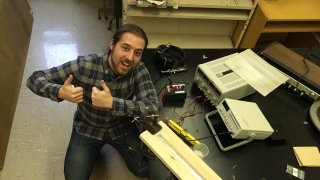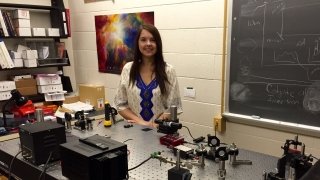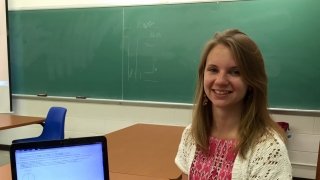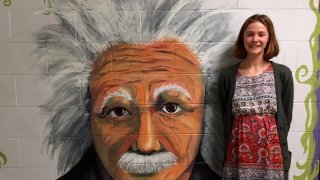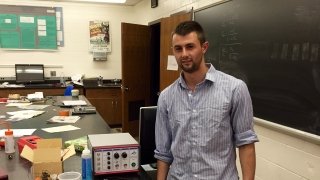Senior Research Projects 2014 - 2015
Seniors present to the physics department the results of their Phys 489/490: SYE Advanced Laboratory and Phys 499: Honors SYE research projects at the end of each semester. The abstracts for their research are below and photos of the student presenters follow afterwards:
Fall 2014
Free and Bound Chladni Plate Experiment - Michael Avanzato '15
All objects have a frequency or set of frequencies with which they vibrate naturally when struck, plucked, strummed, or somehow disturbed. Each of the natural frequencies at which an object vibrates is associated with a standing wave pattern. When an object is forced into resonance vibrations at one of its natural frequencies, it vibrates in a manner such that a standing wave is formed within the object. At any other frequency, the interference of the incident and reflected waves will result in a disturbance that is both irregular and non-repeating.
This principle gives us insight into the workings of the Chladni Plate acoustical experiment. Ernst Chladni, a German born physicist, is well known for his technique used to demonstrate the vibrational modes of simple shaped plates. His technique used a metal plate that was clamped at the center by a stand, which would then be bowed along the edge to make it vibrate. To visibly see the nodal patterns on the plate, Chladni would pour a fine layer of sand on the plate that would rearrange itself to the natural nodal patterns created when the plate was bowed. The patterns created within the plates vary from plate to plate and can be determined through knowing several properties of the plate being used, such as Young’s Modulus, the thickness and size of the plate. Altogether, this set up is known as the Chladni Plate experiment. I will examine the motion of center-driven and outer bound Chladni plates.
For more information, contact Dr. Catherine Jahncke
Spring 2015
Replicating the Quantum Eraser - Sophie Foreman '15
The Observer Effect is defined as a change made in a system when that system is observed. Although most frequently encountered in psychology, the Observer Effect is also a phenomenon in quantum mechanics. A quantum eraser is an experiment that attempts to circumvent Observer Effect by identifying the path of a photon passing through a double slit. Its purpose is to explain the presence of interference patterns created when just one photon passes through at a time, without consequently destroying the pattern. The experiment is so named because the path is “erased” while a separate entangled photon is typically used to indicate the path. We conducted a single-photon quantum eraser experiment using a Mach-Zehnder interferometer, rather than a double slit, to create interference. Half wave plates (HWP) were placed in each arm of the interferometer where they could be rotated to create distinguishable or indistinguishable paths. A polarizer placed at the output of the interferometer was used to remove the affect of the HWPs. This last polarizer is our eraser. This experiment could be explained classically were it not a single-photon phenomenon; classically single photons do not interfere with themselves. An entangled idler photon was used to ensure observation of single photons. We present the results of our single photon experiment, and we describe a double-photon quantum eraser in which the state of both the idler and signal photons are changed to destroy interference when which-path information is created in accordance with the Observer Effect.
For more information, contact Dr. Catherine Jahncke
A Furthered Further Exploration of Bohmian Mechanics - Christina Gay '15 (Honors SYE)
The standard probabilistic interpretation of quantum mechanics states that trajectories for subatomic particles cannot exist. However, in the 1950's David Bohm developed a contradicting, deterministic interpretation using ideas from Louis de Broglie's pilot wave theory to explain particle behavior (including predicted trajectories) through an inherent force formed by the wave function itself. Though the Bohmian interpretation differs greatly from the standard interpretation, both models are supported by all current experimental results. Our research develops a deeper understanding of Bohmian mechanics using Mathematica to model trajectories of a particle in a two dimensional harmonic oscillator potential. We examine how the trajectory properties depend on the particular linear combinations of oscillator states by analyzing animations of the particles' movement and we show how they are consistent with the traditional interpretation.
For more information, contact Dr. Brian Watson
Einstein’s Theory of Special Relativity: a Case Study of How Models are Used in Physics - Abagael Giles '15
Special relativity is a scientific theory according to Ronald Giere’s definition, which holds models as, “abstract entities having all and only the properties ascribed to them in the standard texts,” and theories as families of models (Giere 78). Special relativity is ambiguous in its status as a scientific theory because, while it clearly makes use of metaphor, Einstein himself acknowledged that the theory was not intended to describe phenomena readily observable in day-to-day life on earth. Einstein developed the theory to explain previously anomalous phenomena recorded in experiments conducted on earth, and yet it does not conceptually map onto any physical framework perceptible to the human sense organs. Despite this being the case, components of the theory such as space-time and inertial reference frames are frequently used by physicists to understand motion and interactions between various objects in space. The abstract nature of this theory and the models that comprise it, its functional fluidity in problem solving and its many components make it a prime candidate for analysis within Giere’s framework.
After analyzing Einstein’s writing using Giere’s text, I will, like Giere, offer a series of case studies from contemporary textbooks and compare them to Einstein’s accounts. The case studies will examine the ways in which subsequent sources express space-time and Einstein’s proof for the equivalence of mass and energy. I will then analyze each case, including Einstein’s own, using Giere’s theory. This is to generate a method of examination consistent with Giere’s approach, which focused on the harmonic oscillator. My analysis will also draw on the work of Kuhn. I claim that certain models used to explain Special Relativity in Physics textbooks constitute Kuhnian exemplars.
For more information, contact Dr. Karen Johnson or Dr. Laura Rediehs
Using Ultrasound to Determine the Speed of Sound at Different Ethanol Concentrations - Joshua Martell '15
We measured the speed of sound in different liquids including water, Sprite, Pepsi, Coca-Cola, corn syrup, mineral oil and ethanol using an ultrasonic device. Additionally, we measured the speed of sound of varying ethanol concentrations. The speed of sound of a liquid equates to the square root of the liquid's bulk modulus divided by the square root of the liquid's density. Using our speed of sound data and accepted values for the material density we calculated the bulk modulus at each ethanol concentration. Water was found to have a speed of sound of 1500 ± 100 m/s and bulk modulus of 2.2 ± 0.6 x 109 N/m2and ethanol was found to have a speed of sound of 1130 ± 20 m/s and bulk modulus of 1.01 ± 0.09 x 109N/m2. Our results showed that as we diluted ethanol with water the speed of sound increased until an ethanol concentration of [0.3], at which point it started to decline until it reached the speed of sound of water. At the peak of the curve, [0.3], we found that the speed of sound was greater than both ethanol and water; this agrees with the data found in the literature. This interesting effect is due to the combination of the way the bulk modulus and the density vary with concentration.
For more information, contact Dr. Catherine Jahncke

